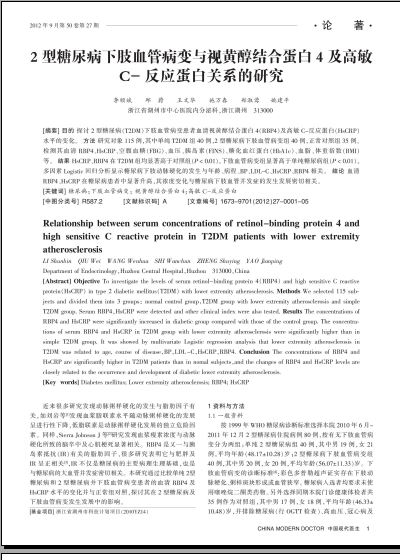型糖尿病下肢血管病变与视黄醇结合蛋白4及高敏C—反应蛋白关系的研究(1)
 |
| 第1页 |
参见附件。
[摘要] 目的 探讨2型糖尿病(T2DM)下肢血管病变患者血清视黄醇结合蛋白4(RBP4)及高敏C—反应蛋白(HsCRP)水平的变化。 方法 研究对象115例,其中单纯T2DM组40例,2型糖尿病下肢血管病变组40例,正常对照组35例。检测其血清RBP4、HsCRP、空腹血糖(FBG)、血压、胰岛素(FINS)、糖化血红蛋白(HbA1c)、血脂、体重指数(BMI)等。 结果 HsCRP、RBP4在T2DM组均显著高于对照组(P < 0.01),下肢血管病变组显著高于单纯糖尿病组(P < 0.01),多因素Logistic回归分析显示糖尿病下肢动脉硬化的发生与年龄、病程、BP、LDL—C、HsCRP、RBP4相关。 结论 血清RBP4、HsCRP在糖尿病患者中显著升高,其浓度变化与糖尿病下肢血管并发症的发生发展密切相关。
[关键词] 糖尿病;下肢血管病变; 视黄醇结合蛋白4;高敏C—反应蛋白
[中图分类号] R587.2 [文献标识码] A [文章编号] 1673—9701(2012)27—0001—05
Relationship between serum concentrations of retinol—binding protein 4 and high sensitive C reactive protein in T2DM patients with lower extremity atherosclerosis
LI Shunbin QIU Wei WANG Wenhua SHI Wanchun ZHENG Shuying YAO Jianping
Department of Endocrinology,Huzhou Central Hospital,Huzhou 313000,China
[Abstract] Objective To investigate the levels of serum retinol—binding protein 4(RBP4) and high sensitive C reactive protein(HsCRP) in type 2 diabetic mellitus(T2DM) with lower extremity atherosclerosis. Methods We selected 115 subjects and divided them into 3 groups: normal control group,T2DM group with lower extremity atherosclerosis and simple T2DM group. Serum RBP4,HsCRP were detected and other clinical index were also tested. Results The concentrations of RBP4 and HsCRP were significantly increased in diabetic group compared with those of the control group. The concentrations of serum RBP4 and HsCRP in T2DM group with lower extremity atherosclerosis were significantly higher than in simple T2DM group. It was showed by multivariate Logistic regression analysis that lower extremity atherosclerosis in T2DM was related to age, course of disease,BP,LDL—C,HsCRP,RBP4. Conclusion The concentrations of RBP4 and HsCRP are significantly higher in T2DM patients than in nomal subjects,and the changes of RBP4 and HsCRP levels are closely related to the occurrence and development of diabetic lower extremity atherosclerosis.
[Key words] Diabetes mellitus; Lower extremity atherosclerosis; RBP4; HsCRP
近来很多研究发现动脉粥样硬化的发生与脂肪因子有关,如刘岩等[1]发现血浆脂联素水平随动脉粥样硬化的发展呈进行性下降,低脂联素是动脉粥样硬化发展的独立危险因素。同样,Sierra Johnson J等[2]研究发现血浆瘦素浓度与动脉硬化所致的脑卒中及心肌梗死显著相关。RBP4是又一与胰岛素抵抗(IR)有关的脂肪因子,很多研究表明它与肥胖及IR呈正相关[3],IR不仅是糖尿病的主要病理生理基础,也是与糖尿病的大血管并发症密切相关。本研究通过比较单纯2型糖尿病和2型糖尿病并下肢血管病变患者的血清RBP4及HsCRP水平的变化并与正常组对照,探讨其在2型糖尿病及下肢血管病变发生发展中的影响。
1资料与方法
1.1 一般资料
按1999年WHO糖尿病诊断标准选择本院2010年6月~2011年12月2型糖尿病住院病例80例,按有无下肢血管病变分为两组:单纯2型糖尿病组40例,其中男19例,女21例,平均年龄(48.17±10.28)岁;2型糖尿病下肢血管病变组40例,其中男20例,女20例,平均年龄(56.07±11.33)岁。下肢血管病变的诊断标准[4]:彩色多普勒超声证实存在下肢动脉硬化、粥样斑块形成或血管狭窄。糖尿病入选者均要求未使用噻唑烷二酮类药物。另外选择同期本院门诊健康体检者共35例作为对照组,其中男17例,女18例,平均年龄(46.33±10.48)岁,并排除糖尿病(行OGTT检查)、高血压、冠心病及其他内分泌代谢病。所有受试者均排除条件:①急慢性感染、糖尿病酮症、高渗性昏迷、手术等应激情况。②恶性肿瘤、缺氧、血液系统疾病、肝胆肾疾病等全身系统疾病。
您现在查看是摘要介绍页,详见PDF附件(4345kb)。